Related Research Articles

STS-51-F was the 19th flight of NASA's Space Shuttle program and the eighth flight of Space Shuttle Challenger. It launched from Kennedy Space Center, Florida, on July 29, 1985, and landed eight days later on August 6, 1985.

Space Shuttle Atlantis is a retired Space Shuttle orbiter vehicle which belongs to NASA, the spaceflight and space exploration agency of the United States. Atlantis was manufactured by the Rockwell International company in Southern California and was delivered to the Kennedy Space Center in Eastern Florida in April 1985. Atlantis is also the fourth operational and the second-to-last Space Shuttle built. Its maiden flight was STS-51-J made from October 3 to 7, 1985.

On Saturday February 1, 2003, Space Shuttle Columbia disintegrated as it reentered the atmosphere over Texas and Louisiana, killing all seven astronauts on board. It was the second Space Shuttle mission to end in disaster, after the loss of Challenger and crew in 1986.
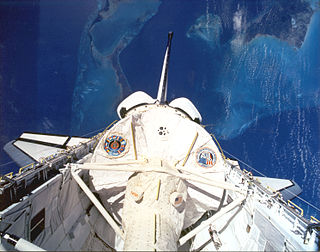
STS-50 was a NASA Space Shuttle mission, the 12th mission of the Columbia orbiter. Columbia landed at Kennedy Space Center for the first time ever due to bad weather at Edwards Air Force Base caused by the remnants of Hurricane Darby.
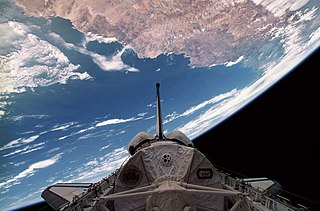
STS-73 was a Space Shuttle program mission, during October–November 1995, on board the Space Shuttle Columbia. The mission was the second mission for the United States Microgravity Laboratory. The crew, who spent 16 days in space, were broken up into 2 teams, the red team and the blue team. The mission also included several Detailed Test Objectives or DTO's.

STS-114 was the first "Return to Flight" Space Shuttle mission following the Space Shuttle Columbia disaster. Discovery launched at 10:39 EDT, July 26, 2005. The launch, 907 days after the loss of Columbia, was approved despite unresolved fuel sensor anomalies in the external tank that had prevented the shuttle from launching on July 13, its originally scheduled date.

Michael Richard Clifford was a United States Army officer and NASA astronaut. Clifford was a Master Army Aviator and logged over 3,400 hours flying in a wide variety of fixed and rotary winged aircraft. He retired from the U.S. Army at the rank of lieutenant colonel. He logged six hours of spacewalk time over three Space Shuttle missions. He was also one of the first people to conduct a spacewalk while docked to an orbiting space station: that spacewalk was conducted during STS-76, while docked at the Russian space station Mir.

Sidney McNeill Gutierrez, is an American pilot and former NASA astronaut. Since retiring from NASA, Gutierrez has worked in several leadership positions at Sandia National Laboratories and Rocket Crafters Inc.

Linda Maxine Godwin is an American scientist and retired NASA astronaut. Godwin joined NASA in 1980 and became an astronaut in July 1986. She retired in 2010. During her career, Godwin completed four space flights and logged over 38 days in space. Godwin also served as the assistant to the director for exploration, Flight Crew Operations Directorate at the Johnson Space Center. Since retiring from NASA, she accepted the position of professor in the Department of Physics and Astronomy at the University of Missouri.

Peter Jeffrey Kelsay Wisoff is an American physicist and former NASA astronaut. Wisoff qualified as mission specialist and flew in four Space Shuttle missions, with his first launch in 1993 and his last in 2000.

STS-121 was a 2006 NASA Space Shuttle mission to the International Space Station (ISS) flown by Space ShuttleDiscovery. The main purposes of the mission were to test new safety and repair techniques introduced following the Columbia disaster of February 2003 as well as to deliver supplies, equipment and German European Space Agency (ESA) astronaut Thomas Reiter to the ISS.
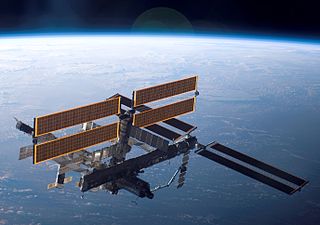
STS-115 was a Space Shuttle mission to the International Space Station (ISS) flown by Space ShuttleAtlantis. It was the first assembly mission to the ISS after the Columbia disaster, following the two successful Return to Flight missions, STS-114 and STS-121. STS-115 launched from LC-39B at the Kennedy Space Center on September 9, 2006, at 11:14:55 EDT.

The Orbiter Boom Sensor System (OBSS) was a 50-foot boom carried on board NASA's Space Shuttles. The boom was grappled by the Canadarm and served as an extension of the arm, doubling its length to a combined total of 100 feet. At the far end of the boom was an instrumentation package of cameras and lasers used to scan the leading edges of the wings, the nose cap, and the crew compartment after each lift-off and before each landing. If flight engineers suspected potential damage to other areas, as evidenced in imagery captured during lift-off or the rendezvous pitch maneuver, then additional regions could be scanned.

STS-133 was the 133rd mission in NASA's Space Shuttle program; during the mission, Space Shuttle Discovery docked with the International Space Station. It was Discovery's 39th and final mission. The mission launched on February 24, 2011, and landed on March 9, 2011. The crew consisted of six American astronauts, all of whom had been on prior spaceflights, headed by Commander Steven Lindsey. The crew joined the long-duration six person crew of Expedition 26, who were already aboard the space station. About a month before lift-off, one of the original crew members, Tim Kopra, was injured in a bicycle accident. He was replaced by Stephen Bowen.
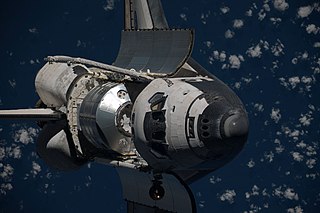
STS-128 was a NASA Space Shuttle mission to the International Space Station (ISS) that launched on August 28, 2009. Space ShuttleDiscovery carried the Multi-Purpose Logistics Module Leonardo as its primary payload. Leonardo contained a collection of experiments for studying the physics and chemistry of microgravity. Three spacewalks were carried out during the mission, which removed and replaced a materials processing experiment outside ESA's Columbus module, and returned an empty ammonia tank assembly.
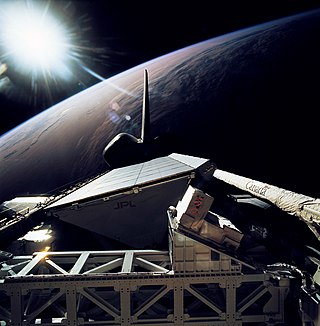
STS-68 was a human spaceflight mission using Space ShuttleEndeavour that launched from Kennedy Space Center, Florida on September 30, 1994.
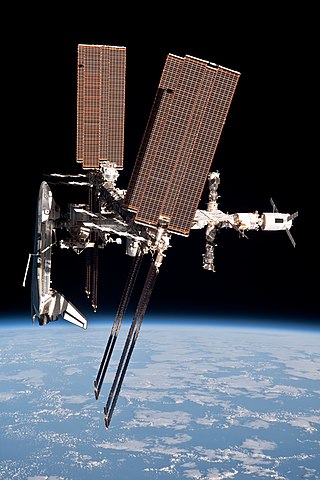
STS-134 was the penultimate mission of NASA's Space Shuttle program and the 25th and last spaceflight of Space ShuttleEndeavour. This flight delivered the Alpha Magnetic Spectrometer and an ExPRESS Logistics Carrier to the International Space Station. Mark Kelly served as the mission commander. STS-134 was expected to be the final Space Shuttle mission if STS-135 did not receive funding from Congress. However, in February 2011, NASA stated that STS-135 would fly "regardless" of the funding situation. STS-135, flown by Atlantis, took advantage of the processing for STS-335, the Launch on Need mission that would have been necessary if the STS-134 crew became stranded in orbit.

STS-135 was the 135th and final mission of the American Space Shuttle program. It used the orbiter Atlantis and hardware originally processed for the STS-335 contingency mission, which was not flown. STS-135 launched on July 8, 2011, and landed on July 21, 2011, following a one-day mission extension. The four-person crew was the smallest of any shuttle mission since STS-6 in April 1983. The mission's primary cargo was the Multi-Purpose Logistics Module (MPLM) Raffaello and a Lightweight Multi-Purpose Carrier (LMC), which were delivered to the International Space Station (ISS). The flight of Raffaello marked the only time that Atlantis carried an MPLM.

Neptec Design Group is an Ottawa-based Canadian vision systems company that provides machine vision solutions for space, industrial, and military applications. Privately owned and founded in 1990, Neptec supplies operational systems to NASA's Space Shuttle and International Space Station programs as one of their prime contractors. In 2000, Neptec expanded its technology to include active 3D imaging systems and 3D processing software. This led to the development of the Laser Camera System, an operational system used by NASA to inspect a shuttle's external surfaces during flight. Neptec also used this system to develop the TriDAR, a 3D imaging and tracking system designed for automated on-orbit rendezvous, inspection, and docking. It combines the LCS with a long range LIDAR sensor into the same optical path.
TriDAR, or Triangulation and LIDAR Automated Rendezvous and Docking, is a relative navigation vision system developed by Neptec Design Group and funded by the Canadian Space Agency and NASA. It provides guidance information that can be used to guide an unmanned vehicle during rendezvous and docking operations in space. TriDAR does not rely on any reference markers positioned on the target spacecraft. Instead, TriDAR relies on a laser based 3D sensor and a thermal imager. TriDAR's proprietary software uses the geometric information contained in successive 3D images to match against the known shape of the target object and calculate its position and orientation.
References
- ↑ "Sandia assists NASA with several shuttle projects," Archived 2006-04-27 at the Wayback Machine Sandia National Laboratories Press Release, August 17, 2005, Retrieved July 7, 2006.
- ↑ STS-97 DTO: Laser Dynamic Range Imager (LDRI)